My First Year as a Beginning Teacher
Author’s Background
I graduated from Nanyang Technological University in 2018 with a Bachelor of Science in Mathematics and Economics with Honours (Highest Distinction). Unlike many of my National Institute of Education (NIE) classmates, teaching was not my first career. I started as a policy officer in one of the ministries in Singapore. However, in 2020, I decided to make a career switch to become a teacher because I realised that was what I wanted to pursue. While this change may be surprising to many, it was not to me because teaching was the first career I had considered given my Bachelor's degree. I recalled spending my university summer breaks taking up relief-teaching jobs and speaking with teachers to better understand the demands of the profession. With all the knowledge and experiences gathered, I applied for a teaching position with the Ministry of Education (MOE) before university graduation. Unfortunately, I did not pass the interview stage.
As quoted by Walt Disney, “All our dreams can come true, if we have the courage to pursue them”. Undaunted by my first failure and under the encouragement of my loved ones, I mustered my courage to apply for a teaching position with MOE again. Fast forward two years later, I have already graduated from the NIE Post-graduate Diploma in Education (PGDE) programme and am now a full-fledged teacher in one of the secondary schools in Singapore teaching Mathematics.
Defining my Teacher Identity
During my stint as a policy officer, I had to attend an elections workshop on one of the working afternoons and was allocated to sit with a group of teachers. During break time, I noticed that the teachers in my group were diligent and did not waste their time resting. Instead, they spent it on marking their students’ essays. At that moment, it dawned on me that teachers continue to develop a student’s learning even outside the classroom. While some may view marking to be an insignificant task, it is important because it allows teachers to assess students’ understanding, identify learning gaps and devise the next appropriate teaching strategies.
I believe that my role as an educator is to develop students with good character and values. One of my most memorable experiences encountered during my untrained contract teaching stint was when one of my students stood up for me against his friend’s behaviour. He said to his friend, “You should walk to Ms Tai when you need help. Not Ms Tai walk to you”. After that comment, he ensured that his friend walked to me and asked me politely for assistance. This heart-warming incident showed me the importance of cultivating good character and values in my students because these will shape how students behave and present themselves, especially in front of their future employers. Glassdoor (2021) highlights that character provides employers an indication of their employees’ working attitude. An employee with good character is likely to submit high-quality work and perform more efficiently.
This heart-warming incident showed me the importance of cultivating good character and values in my students because these will shape how students behave and present themselves, especially in front of their future employers.
I also see the need for myself to be a curious educator who is not afraid to try different teaching strategies to spark students’ interest in learning. In one of my Mathematics lessons during my untrained contract teaching, I had to teach the topic of equation of circles. Instead of using a didactic teaching approach, I decided to use GeoGebra and a guided-discovery approach to develop this concept. While it was my first time using such teaching tool and strategy, I was satisfied with the lesson as my students were engaged and participative. In particular, I had a student who often slept during lesson time. However, for that lesson, he was awake and responsive. He later came up to me after class to thank me for the lesson and said he liked and understood the lesson well. That lesson taught me the importance of constantly discovering and using new teaching strategies and tools to cater to the diverse learners in my classroom. I see it as my role to make learning interesting and meaningful even though students may not appreciate the subject. When students are engaged in the learning process, it leads to an increase in attention and motivation for higher-order thinking (University of Washington, 2022).
“Heart” Work in Teaching
I aspire to be a teacher who has a big heart to love and support all my students regardless of how difficult they may be. In my first year of teaching, I had my fair share of encountering motivated and hardworking students, and those who were disruptive and unresponsive to my support. As the academic year passed, I found myself feeling more weary and doubtful of the support I can provide to my difficult students. Looking at the progress I made with them, there were times I thought of giving up and channelling less help to them. However, I was constantly reminded of my teaching philosophies through my mentor’s words of encouragement and assurance. He believes that all children can learn, and as a professional educator, I should not “give up easily” and continue to “find strategies to win over these difficult students”.
One of my teaching philosophies is “I teach students, not subjects”. During my first work experience, I finally realised that achieving academic success may not necessarily mean achieving success in life. Other aspects such as learning to work in teams, understanding our social-emotional competencies and good values are important too. Hence, as a teacher, I recognise the importance of developing each student holistically, beyond just the academic subjects that I teach. This belief tided me through practicum and my first year of teaching because it constantly reminded me to place the development of my students at the centre of my teaching.
As a teacher, I recognise the importance of developing each student holistically, beyond just the academic subjects that I teach.
In my first teaching semester, I had the privilege to help Student C tide through the hardships she was facing. Student C caught my attention because she is an intelligent student with the potential to excel. Yet, she showed difficulties in submitting her work promptly and a sluggish learning attitude. Maslow (1954) believes that an individual’s behaviour is shaped towards satisfying his/her basic needs. Once an individual has attained his/her deficiency needs, he/she is motivated to attain growth needs. I started having small chats with Student C to better understand the difficulties she was facing. The first few talks were unsuccessful because student C did not reveal much and her work performance remained poor. The breakthrough moment came after speaking with Student C’s mother. Through my conversation with her mother, I could empathise and understand the struggles that Student C faced at home. Equipped with this information, I engaged in another chat with Student C. However, this time, the focus of the chat was on the trouble that she faced at home and how she could cope with it. Through that chat, Student C was able to better understand her parents’ expectations and worries, manage her time and understand the consequences of her poor learning attitude on achieving her dreams. She was subsequently able to focus in class and even took the initiative to book consultations with me to clear her learning doubts.
Learning Goals
According to Seifert (2019), learning does not occur if a student immediately forgets what they have learnt. Hence, my learning goal for students is to develop conceptual understanding on the topics taught, instead of merely memorising them. When students develop conceptual understanding, Jain (2021) highlights that it will allow them to apply what they have learnt, make connections with prior knowledge and build on it further. I adopted various teaching strategies in class to develop students’ conceptual understanding. For example, in my recent lesson on cylinders, I used a guided-discovery approach, a constructivist-based learning model (Amiyani & Widjajanti, 2018) to develop students’ conceptual understanding on the formulae for finding the total surface area of the different types of cylinders. Through the use of available resources on GeoGebra, my students were able to visualise the net of a closed cylinder and derive the formula for finding its total surface area. Their understanding of the lesson had allowed them to quickly apply and articulate the formulae for finding the total surface area of an open and a hollow cylinder when real-life objects such as a container and toilet roll were shown to them. The outcomes observed in class support the study by Amiyani & Widjajanti (2018) who note that guided-discovery learning improves students’ critical thinking and mathematical reasoning.
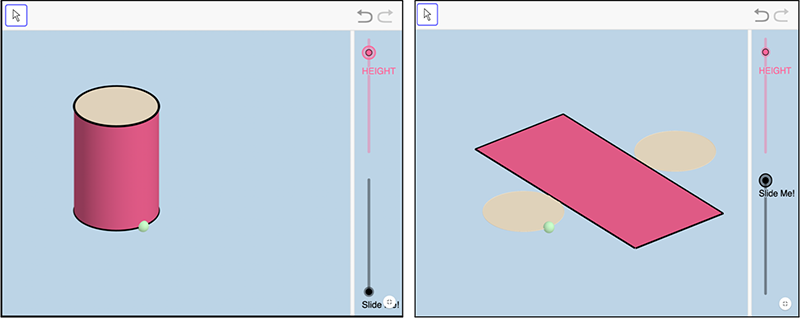
A snapshot of an existing GeoGebra manipulative that was used in class to develop students’ understanding on finding the total surface area of a cylinder.
In the process of learning, failure is inevitable. While failure can be daunting to students, it allows them to develop character strengths and social-emotional competencies (Lavoie, 2021). Hence, after each Weighted Assessment (WA), I would always remind my students that there are opportunities for growth whenever we encounter failure. In the Term 3 WA, my students did not perform well. Many felt that they did not achieve their targets, especially those set by their parents. I recalled the heavy and tense silence in class when I returned and went through the papers. Putting myself in the shoes of my students, I was sure my students had wanted some encouragement. That night, I shared my failure story to let them know that I have encountered failures too. This sharing allowed my students to be more open to the idea of failing and see it as an opportunity for growth in their education journey.
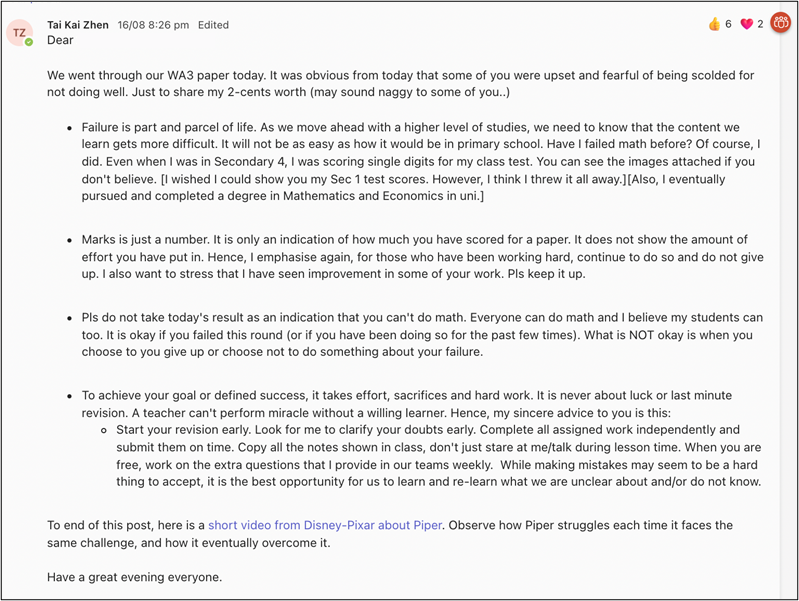
An encouragement post to students after they received their results.
The Four-Life Learning Model
In 2017, the NIE proposed the Four-Life Learning Model to prepare students to excel in the volatile, uncertain, complex, and ambiguous (VUCA) world. According to Kwek et al. (2017), the Four-Life Learning Model seeks to provide students with “purposeful learning” through four forms – life-wide, life-deep, life-long, and life-wise. Huang (2022) shares that these four forms of learning should not be viewed in silos as learning in each form can affect one another.
On the topic of rounding and significant figures, students learnt how to round off numbers to the required decimal and significant places. To make learning more purposeful and relevant to their daily lives, I got my students to discuss the differences and rationale for “rounding down to the nearest 5 cents” and “rounding to the nearest 5 cents” in a supermarket (Figure 3). During the discussion, I observed how students were able to provide logical reasons for the different forms of rounding based on their personal experiences. There were also opportunities for the class to discuss the relevance of rounding with the use of credit cards and the different denominations of Singapore’s currency. For the latter, I even had the opportunity to introduce the 1-cent to my students because many thought that 5-cents is the smallest denomination in Singapore.

Classroom discussion on rounding. (Question taken from Secondary 1 Think! Mathematics textbook)
Upon reflection, I realised that the discussion on rounding is a good example of purposeful learning because students were able to experience life-wide, life-deep, and life-long learning. Firstly, as a student, I always felt that the topic of rounding was abstract and procedural because it only involved applying the different rounding rules to round a given number to its required significant and/or decimal places. Hence, the classroom discussion encouraged life-long learning because students were given the opportunity to connect their learning to a purpose. The discussion topic sets a context for learning and allowed students to better appreciate the importance of rounding and its application to their daily lives. Secondly, students were able to share their personal experiences with their shoulder partners and make connections between their experiences and concepts learnt. For example, by comparing the different rounded values, some of my students were able to justify the supermarkets’ practices to round down the items purchased to the nearest 5 cents. This form of learning supports Piaget’s Theory of Constructivism (Wadsworth, 2004), which states that students learn more effectively when they actively construct and connect their new knowledge with their prior experiences. Lastly, encompassing life-long and life-wide learning, it is important that students develop conceptual understanding first before they can apply it in a real-world context. Therefore, the discussion topic steers away from the usual pen-and-paper exercises and enabled students to delve deeper into the topic, and articulate the different types of rounding and the rationale for doing so.
Process of Inquiry and Reflection
As a Beginning Teacher, I was constantly worried that my students were not learning well under my tutelage. I was also concerned whether more support could be provided to help my students’ in their learning. Hence, after the Term 1 WA, I got my classes to complete a post-WA reflection. In the reflection, students had to reflect on their learning habits and areas done well, identify their mistakes and suggest ways for improvement. They were also required to provide suggestions on the support I could provide to make learning enjoyable and meaningful for them. The survey results collated were beneficial (Figure 4) because it provided me with a clear understanding of my students’ expectations from a lesson and ways I could improve to better cater to their learning needs. For example, many students suggested to gamify parts of the lesson to make learning more interesting and engaging. Hence, rather than the usual pen-and-paper exercises, I conducted games in class to arouse students’ curiosity and assess their level of understanding for the lesson taught. Some of the games conducted include letting students play an online Battleship game to understand the concept of cartesian coordinates and administering Kahoot quizzes to check for students’ prior knowledge and understanding. The use of games in class definitely made lessons more interesting. Students were also observed to be more engaged during lesson time and focused in attempting the activities without much reminders. There was also an improvement in academic achievements in the Term 2 WA, which was similar to the observation made by Dyer (2021).

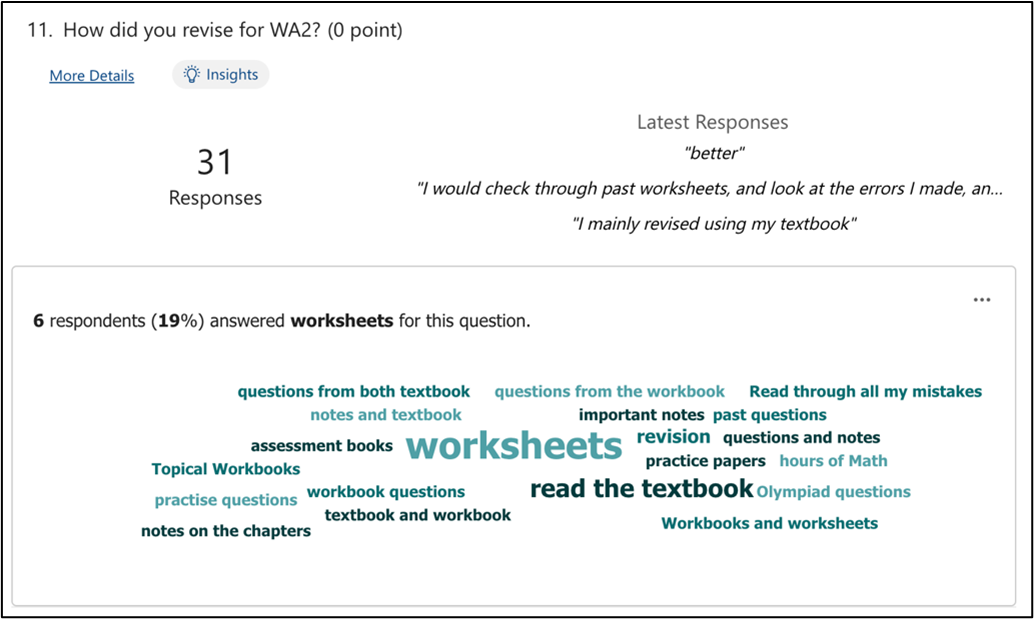
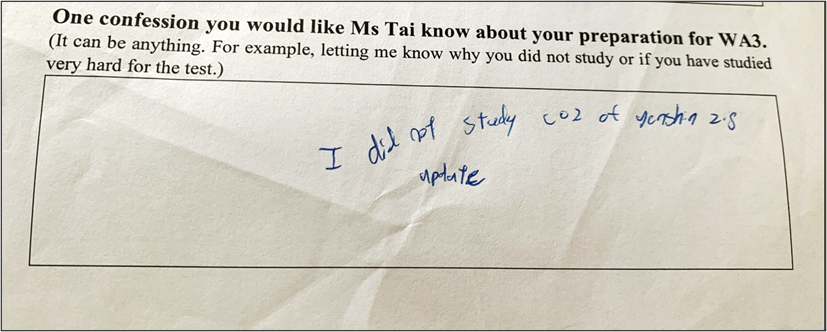
Responses gathered across the three post-WA reflections to guide me in understanding my students better and ways to improve my teaching approaches.
In my mid-year review with my Reporting Officer, there were discussions on encouraging students to be more self-directed. According to Lee & Mori (2020), self-reflection and peer feedback are important components in developing students’ self-directed learning competencies. For self-reflection, Lee & Mori (2020) shared that it allows students to gain clearer insights into their learning, provides opportunities for them to diagnose their learning gaps and devise appropriate strategies to improve. Reflection is a teaching strategy that I often use in class because I believe that the process of reflection allows us to consolidate our learning. My students had to be independent in their learning nearing the examination season as I was away for national examinations invigilation. To ensure that my students diligently listened through my pre-recorded lectures and understood the content, they were required to complete and submit a short and detailed reflection on their learning. The reflections collated allowed me to have a quick grasp on my students’ level of understanding and common mistakes made in their work (Figure 5). These information helped me in my lesson preparation as I had to make decisions on the coverage and sequence for the next lesson.
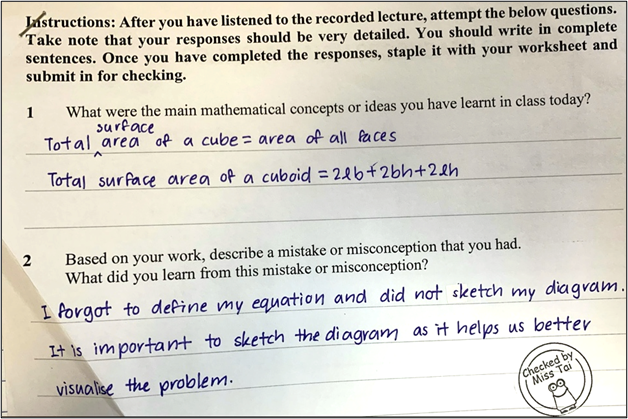
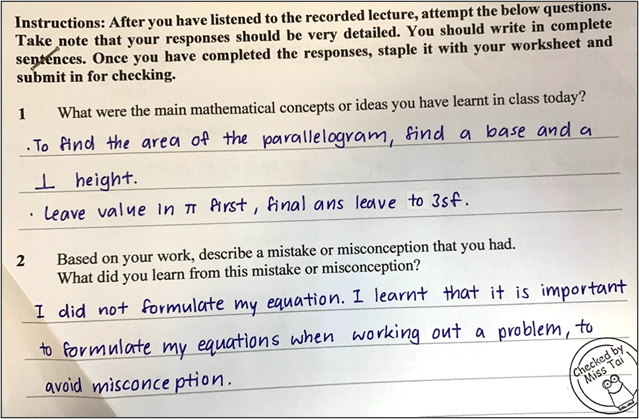
A sample of student’s reflections on the key learning points they have learnt from the pre-recorded lectures and areas of improvements based on their work.
For peer feedback, Yang et al. (2006) highlighted that it can lead to academic improvements and provide students with greater autonomy in their studies. Similarly, Boud et al. (1999) state that peer feedback can challenge students to reflect and re-evaluate their learning. I started introducing peer marking and peer feedback in Term 2. Initially, my students struggled with these tasks because they were unsure of the expectations and feedback they could provide. It was common to see students accepting their classmates’ work even if the method of presentation was incorrect or lacking. There was no written feedback provided too. With more practice, there was an improvement in the students’ ability to give feedback. Some were seen providing reminders mentioned by me in class, as well as pointers and encouragement to their classmates’ work.
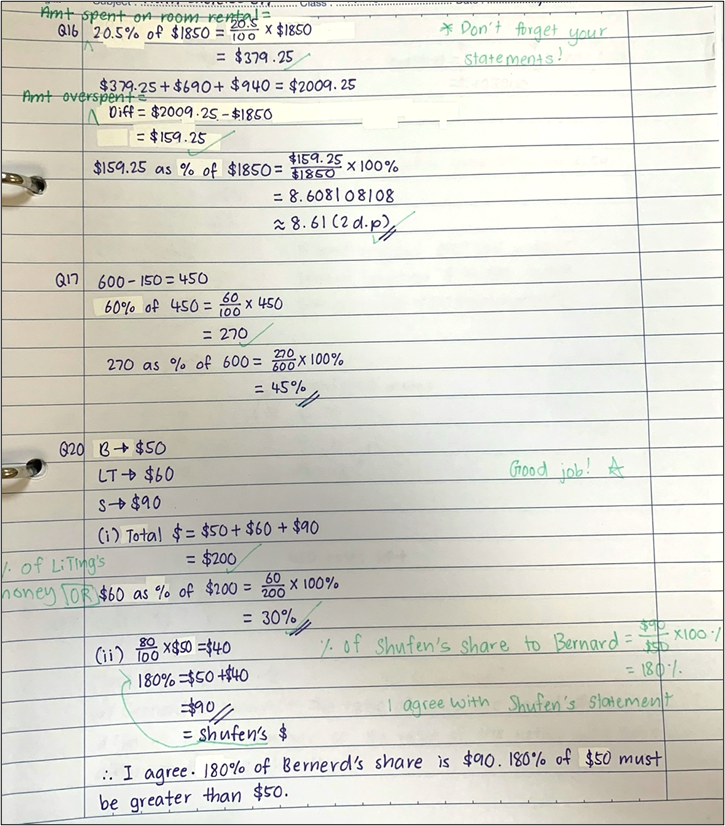
A sample of peer marking and feedback provided to one of their classmates’ work.
Growth and Development
Over the course of my first year in teaching, there were definitely ups and downs experienced. Notwithstanding the obstacles encountered, I will always remind myself to rejoice in the small achievements that I have witnessed. This could be as simple as acknowledging the improvements made by my students in their daily assignments or appreciating the trust and bond that I have built with my classes over a short period of time.
As an educator, I believe in the importance of reflection. This was also one of the greatest takeaways I had from NIE. I recalled how my NIE mathematics professor would allocate the last five minutes of his lessons to allow us to reflect on our learning. Similar to how I provide time for my students to reflect on their learning, as a professional educator, I should also constantly reflect and review my teaching philosophies, approaches and strategies. As the saying goes, “Change in the only constant”. Only with constant reflection can we then have better foresight on our plans and identify areas for growth.
Finally, when things get tough, we must always remind ourselves of our original motivation for joining the fraternity and the impact we bring to our students.
References
Amiyani, R., & Widjajanti, J. B. (2018, September). The Excellence of Guided Discovery Learning on Mathematical Knowledge-Based, Skill-Based, and Attitude. Journal of Physics: Conference Series, 1097, 012145. https://doi.org/10.1088/1742-6596/1097/1/012145
Boud, D., Cohen, R., & Sampson, J. (1999, December). Peer Learning and Assessment. Assessment & Evaluation in Higher Education, 24(4), 413–426. https://doi.org/10.1080/0260293990240405
Dyer, K. (2021, August 17). Research proof points: Better student engagement improves student learning. Teach. Learn. Grow. Retrieved October 12, 2022, from https://www.nwea.org/blog/2015/research-proof-points-better-student-engagement-improves-student-learning/
Glassdoor. (2021, June 30). Important Character Traits for the Workplace – Glassdoor Career Guides. Retrieved September 28, 2022, from https://www.glassdoor.com/blog/guide/character-traits/
Huang, D. (2022, March). ST80 Guest Editor’s Note. Singteach. Retrieved October 11, 2022, from https://singteach.nie.edu.sg/2022/04/19/st80-guest-editors-note/
Kwek, D., Hung, D., Koh, T. S., & Tan J. (2017). OER-CRPP Innovations for Pedagogical Change: 5 Lessons. Singapore: National Institute of Education.
Lavoie, M. (2021, October 13). The Role of Failure in Learning. Oxford Learning. Retrieved October 1, 2022, from https://www.oxfordlearning.com/the-role-of-failure-in-learning/#:%7E:text=Failure%20is%20a%20part%20of,is%20an%20opportunity%20to%20grow.
Lee, H., & Mori, C. (2020, June 10). Reflective practices and self-directed learning competencies in second language university classes. Asia Pacific Journal of Education, 41(1), 130–151. https://doi.org/10.1080/02188791.2020.1772196
Maslow, A. H. (1954). Motivation and personality. New York: Harper and Row.
Seifert, K. (2019, May 1). The learning process – Educational Psychology. Pressbooks. Retrieved October 1, 2022, from https://uwgedpsych.pressbooks.com/chapter/the-learning-process/
University of Washington. (2022, July 12). Engaging students in learning. Center for Teaching and Learning. Retrieved September 28, 2022, from https://teaching.washington.edu/topics/engaging-students-in-learning/#:%7E:text=Research%20has%20demonstrated%20that%20engaging,in%20higher%2Dlevel%20critical%20thinking.
Wadsworth, B. J. (2004). Piaget’s Theory of Cognitive and Affective Development: Foundations of Constructivism. Longman Publishing.
Yang, M., Badger, R., & Yu, Z. (2006, December). A comparative study of peer and teacher feedback in a Chinese EFL writing class. Journal of Second Language Writing, 15(3), 179–200. https://doi.org/10.1016/j.jslw.2006.09.004

